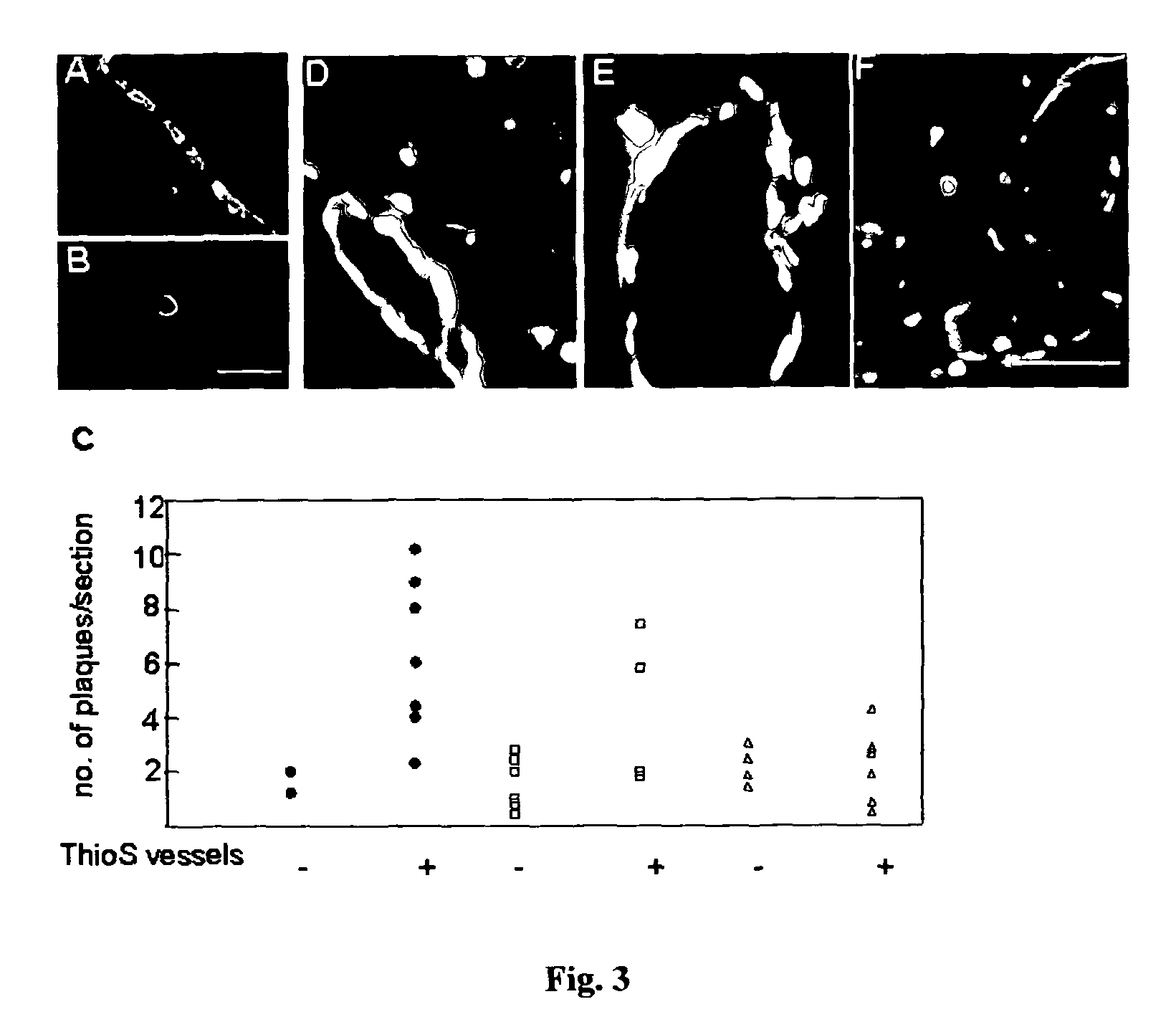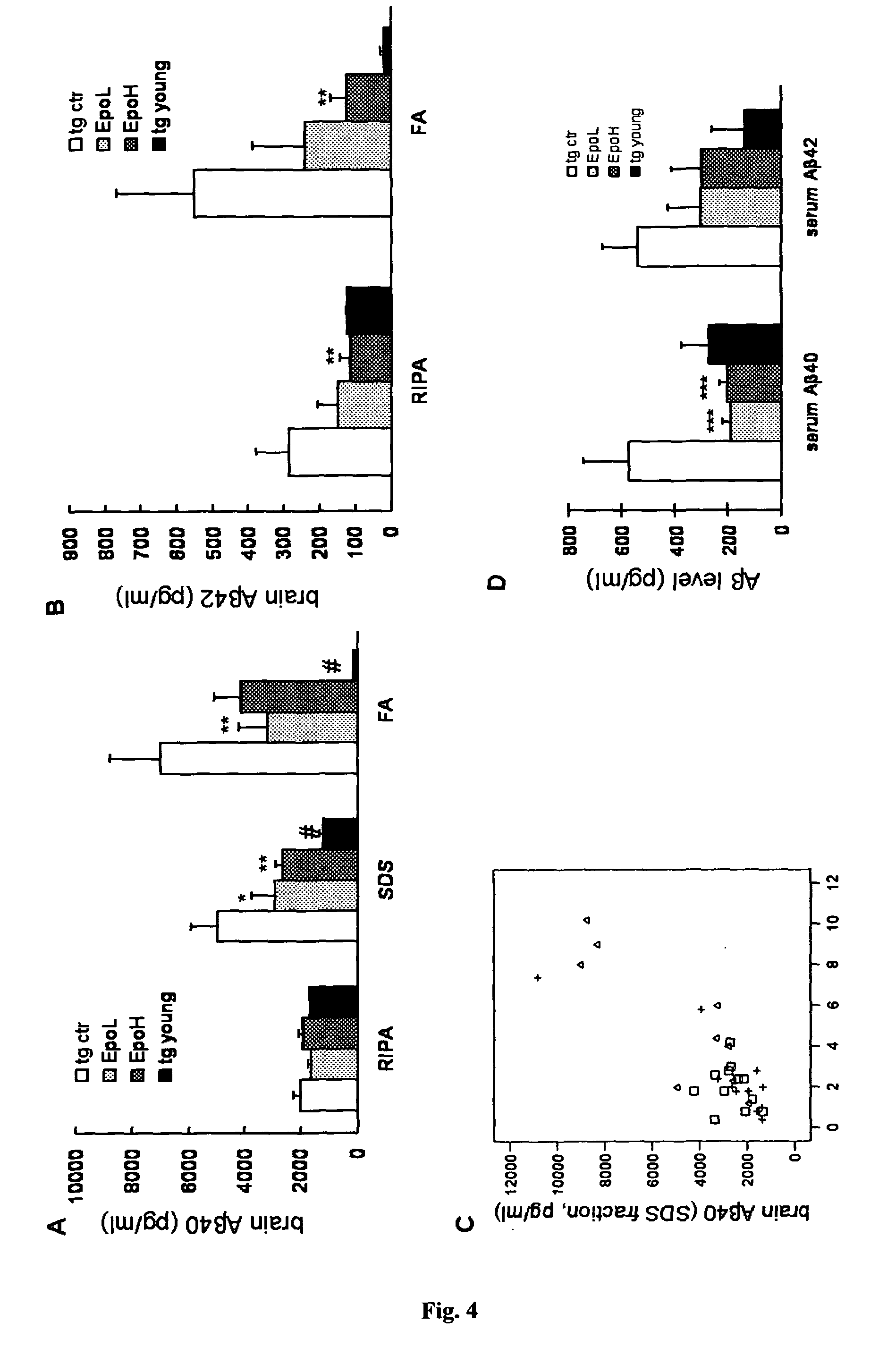Noveltreatment for neurological disorders
a neurological disorder and treatment technology, applied in the field of neurological disorders, can solve the problems of speech impairment and loss of coordination, lack of effective therapies or cures, emotional disturbance, etc., and achieve the effects of reducing protein level, reducing claudin-5, and meliorating early a pathology and microvessel disintegration
- Summary
- Abstract
- Description
- Claims
- Application Information
AI Technical Summary
Benefits of technology
Problems solved by technology
Method used
Image
Examples
example 1
rHuEPO Reduces the Number of Aβ Plaques and Aβ Plaque-associated Astrocytosis in the Brain
[0102]At eight months of age, arcAβ mice had already developed marked Aβ deposits in the brain parenchyma and leptomeningeal and parenchymal blood vessels, which were revealed by 6E10 immunofluorescence staining. Most of the 6E10-positive Aβ deposits were confirmed by thioflavin-S staining as neuritic plaques (FIGS. 1A, B and C). Thioflavin-S plaques appeared predominantly in the cortex (5.0±1.09 / section), but rarely in the hippocampus. The number of plaques was reduced by more than 40% in EpoL and EpoH (2.6±0.6 / section and 2.0±0.3 / section respectively; P<0.05 and 0.01, LSD, FIG. 1D). Astrocytosis in response to Aβ accumulation in brain parenchyma was already prominent in eight-month-old tg ctr (FIG. 2D). In contrast, Aβ plaque-associated astrocytosis was markedly reduced in EpoL (FIG. 2E) and EpoH (FIG. 2F), as determined by the number of GFAP-positive cells and the fluorescence intensity surr...
example 2
rHuEPO Reduces CAA and Maintains the Close Contact Between Astrocytes and Blood Vessel
[0103]Thioflavin-S staining also revealed significant CAA in eight-month-old arcAβ mice, both in the leptomeninges and the cortex (FIGS. 3A and B). The appearance of thioflavin-S stained vessels positively correlated to the number of thioflavin-S plaques in the cortex (P<0.05, r=0.725, Spearman's rho correlation coefficient, FIG. 3C). However, thioflavin-S stained vessels were less prominent in EpoL and EpoH (5 of 11 and 7 of 12 respectively). Interestingly, there was no association between the number of thioflavin-S plaques and the appearance of thioflavine-S vessels in EpoL and EpoH mice (P=0.253 and 0.647 respectively, FIG. 3C). However, Perls staining of ferric iron did not detect any microhemorrhage in brains of all four groups (unpublished data). This indicates microhemorrhage occurred in arcAβ mice later than did CAA. In addition, despite being highly GFAP-reactive, astrocytes mostly detache...
example 3
rHuEPO Lowers Brain and Serum Aβ Levels
[0104]Brain Aβ in RIPA, SDS and FA fractions were quantified with ELISA. Compared with four-month-old arcAβ mice which had no detectable Aβ plaques in the brain, eight-month-old tg ctr mice had only a slight increase in Aβ40 in RIPA fraction (P=0.210), but a four-fold increase in SDS fraction and a 40-fold increase in FA fraction (P<0.01, FIG. 4A). Chronic rHuEPO treatments reduced the Aβ40 level only slightly in RIPA fraction (P=0.211, FIG. 4A), but dramatically in less soluble fractions by more then 40%. The reduction of Aβ40 was significant in SDS fraction in EpoL, as well as in FA fraction in EpoH (P<0.05, FIG. 4A). The levels of brain Aβ42 in rHuEPO treated mice reduced by a similar degree and the reductions were significant in RIPA and FA fraction of EpoH (P<0.05, FIG. 4B). Further analyses showed that the number of thioflavin-S plaques was positively associated with brain Aβ levels in all RIPA-insoluble fractions (P<0.001, Pearson correl...
PUM
| Property | Measurement | Unit |
|---|---|---|
| molecular weight | aaaaa | aaaaa |
| molecular weight | aaaaa | aaaaa |
| body weight | aaaaa | aaaaa |
Abstract
Description
Claims
Application Information
 Login to View More
Login to View More - R&D
- Intellectual Property
- Life Sciences
- Materials
- Tech Scout
- Unparalleled Data Quality
- Higher Quality Content
- 60% Fewer Hallucinations
Browse by: Latest US Patents, China's latest patents, Technical Efficacy Thesaurus, Application Domain, Technology Topic, Popular Technical Reports.
© 2025 PatSnap. All rights reserved.Legal|Privacy policy|Modern Slavery Act Transparency Statement|Sitemap|About US| Contact US: help@patsnap.com



